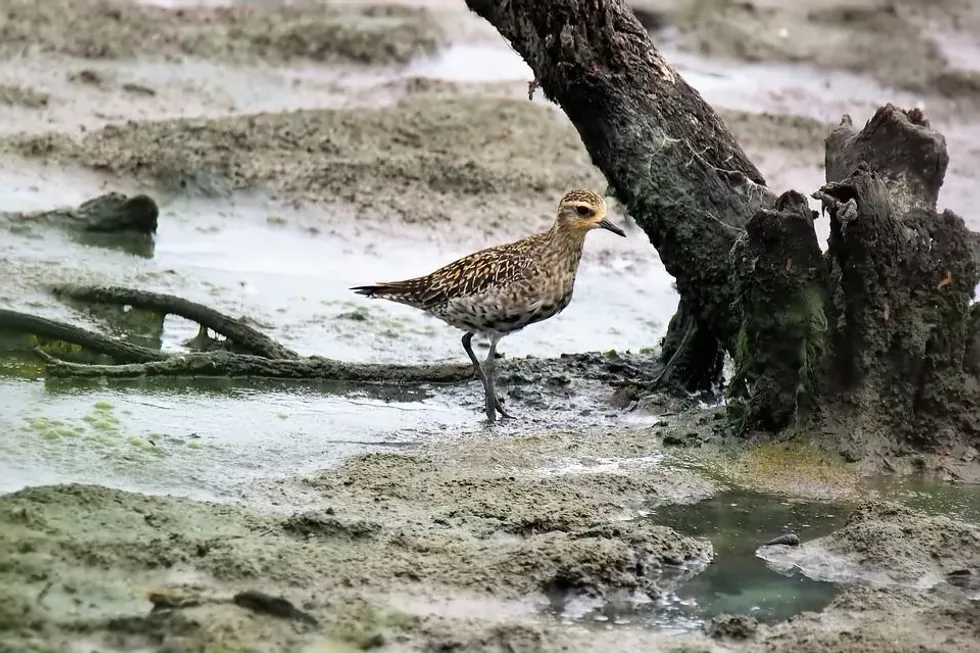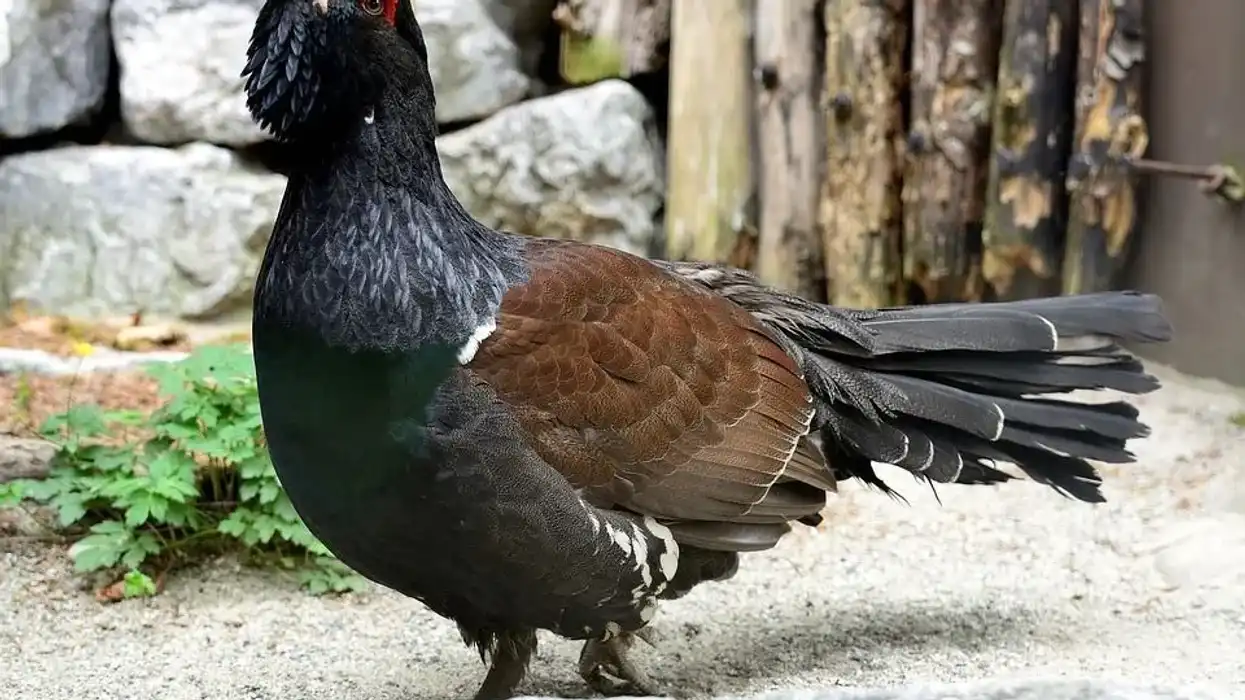The American golden plover is a family of golden plover birds. The American golden plover scientific name is Pluvialis dominica.
They are brown and golden in color with a white stripe on its head. This bird species is mostly found mostly in North America, South America, the Arctic Pacific ocean, and from southeast Asia to Northeastern Africa.
Tundra and grassland regions are their main habitat area, and sometimes even wetlands and swamps, but very rarely since they prefer dry lands. Their population has been observed to be declining due to climate change, so it may be a threat to their population in the future.
The diet of these birds mostly consists of insects. Adult American golden plovers are medium-sized and weigh between 120-190 g, with a length of 9-11 in (24-28 cm).
Their migration takes place from time to time in search of pleasant weather conditions, especially during wintering grounds. It is extremely similar to the Pacific golden plover. They migrate during fall or winter, through central North America, and are uncommon on the East coast and rare on the Pacific coast.
If you have an interest in birds, keep reading, and you should check out the Arctic tern and Sanderling as well.
American Golden Plover Interesting Facts
What type of animal is an American Golden Plover?
American golden plovers are bird types of animals and belong to the Charadriidae family.
What class of animal does an American Golden Plover belong to?
As a bird species, it belongs to the Aves class of animals.
How many American Golden Plovers are there in the world?
The total number of American golden plovers present across the world are unknown since they are spread widely in different areas and region. Their population is stable, but declining is a recent trend that has been observed in several regions.
Where does an American Golden Plover live?
The grassland and Arctic tundra region are preferred by these birds for their settlement. The American golden plover nest sites are selected by the male, and then he builds a shallow scrape on the ground and lined with dry grasses and moss. They can also be found in the Arctic tundra, South America, and avoid wintering grounds.
What is an American Golden Plover's habitat?
American golden plovers use a variety of habitats during the fall and spring migration, including estuaries, coastal mudflats, and adjacent salt marshes. They nest primarily on the arctic and subarctic tundra of North America and on South American grasslands in winter.
However, the American golden plover migration occurs seasonally. The adults leave Arctic breeding grounds in early summer, but the juveniles linger until late summer.
Who do American Golden Plovers live with?
The American golden plover, Pluvialis, generally lives in pairs during the breeding season to incubate the chicks, but mostly they live alone unless they are migrating in groups.
How long does an American Golden Plover live?
They usually have a lifespan with a range between 7-11 years, unless they are hunted down by predators before they have hatched. In some cases, they can live above 11 years too.
How do they reproduce?
When the breeding season begins, the plovers engage in 'torpedo runs' which is a courtship display, and this occurs in the first few days of reaching their breeding grounds.
Males chase the female while exhibiting wing lifts and trill sounds and will separate the female from other members while fighting off any males who come nearby. The male plovers also perform a flight song when reaching the breeding grounds to attract their mate.
They are monogamous and mate with only one partner.
Breeding occurs shortly after reaching the breeding grounds and the breeding female lays up to four eggs a few weeks later. Their eggs are white or creme in color with black and brown spots.
The males usually incubate the eggs at day and the females incubate them at night, and the chicks once hatched, are extremely precocial and can feed by themselves within a few hours of hatching.
What is their conservation status?
The conservation status of the American golden rovers is Least Concern but can be under threat in the future due to their decreasing population.
American Golden Plover Fun Facts
What do American Golden Plovers look like?
American golden plovers are slender, long-winged plovers found in dry habitats. The breeding plumage has a black belly, white stripe on the head, with dark brown and gold feathers in its body.
The white stripe helps them differentiate from other plovers. Nonbreeding plumage is grayish overall with a dark cap and distinct white eyebrow. Juveniles are washed with gold on the upper parts which is crisp and neatly spangled above.
Juveniles of the American golden plover are duller than those of the Pacific, especially on the neck and face. All plovers bird species differ in looks and colors in some way even though they may look similar overall, in detail, they have different features.
How cute are they?
Their golden touch with black and white stripe makes them unique and attractive, which is undoubtedly cute to watch.
How do they communicate?
The American golden plover, Pluvialis, communicates using different calls including trill, alarm calls, and main/wail songs. The call consists of whistles, yodel whistles, as well as sounds like 'too-leet, too-leet'.
How big is an American Golden Plover?
American golden plovers are 10 times bigger than a sparrow.
How fast can an American Golden Plover fly?
These bird species, during their migration, can fly up to 60 mph. They have a good flying speed like other birds that fly long distances. In the fall, it can fly non-stop from the East coast of North America to South America. They are known to cover great distances in flight during migration.
How much does an American Golden Plover weigh?
American golden plovers weigh between 120-190 g.
What are their male and female names of the species?
There is no separate name for females and males of this bird species. But the females are mostly called breeding females.
What would you call a baby American Golden Plover?
The babies of these birds are called chicks, like any other birds species.
What do they eat?
The American golden plover bird diet consists of grasshoppers, caterpillars, beetles, and all other insects, and sometimes even berries.
Are they dangerous?
These birds often show aggressive nature when fighting for territory or nest, especially during the breeding season, but overall, they are not dangerous in nature.
Would they make a good pet?
This bird species follow migration to other suitable regions during certain seasons, and having them enclosed in a cage would not be ideal for them since they like to be free and independent. In theory, though, they would make a good pet.
Did you know...
The oldest American golden plover found was at least 13 years old.
They are capable of maintaining or storing seeds in their digestive tract to help them survive a long flight, especially during their migration.
The American golden plover has a circular and long migration route.
Among the shorebirds, these bird species are probably one of the fastest fliers
What is special about the American Golden Plover?
American golden plovers can fly up to 20,000 mi per year, including a non-stop flight of between 3000-3500 mi over the Atlantic. They are able to reach flight speeds of up to 60 mph.
American Golden Plover vs Black-Bellied Plover
Black-bellied plover birds are larger than American golden plovers with a thick bill. The American golden plover bird's head is roundly shaped and has a distinct eyebrow, whereas, the black belied plover birds have a faint eyebrow.
Here at Kidadl, we have carefully created lots of interesting family-friendly animal facts for everyone to discover! Learn more about some other birds including Sanderling, or hamerkop.
You can even occupy yourself at home by drawing one on our American Golden Plover coloring pages.









